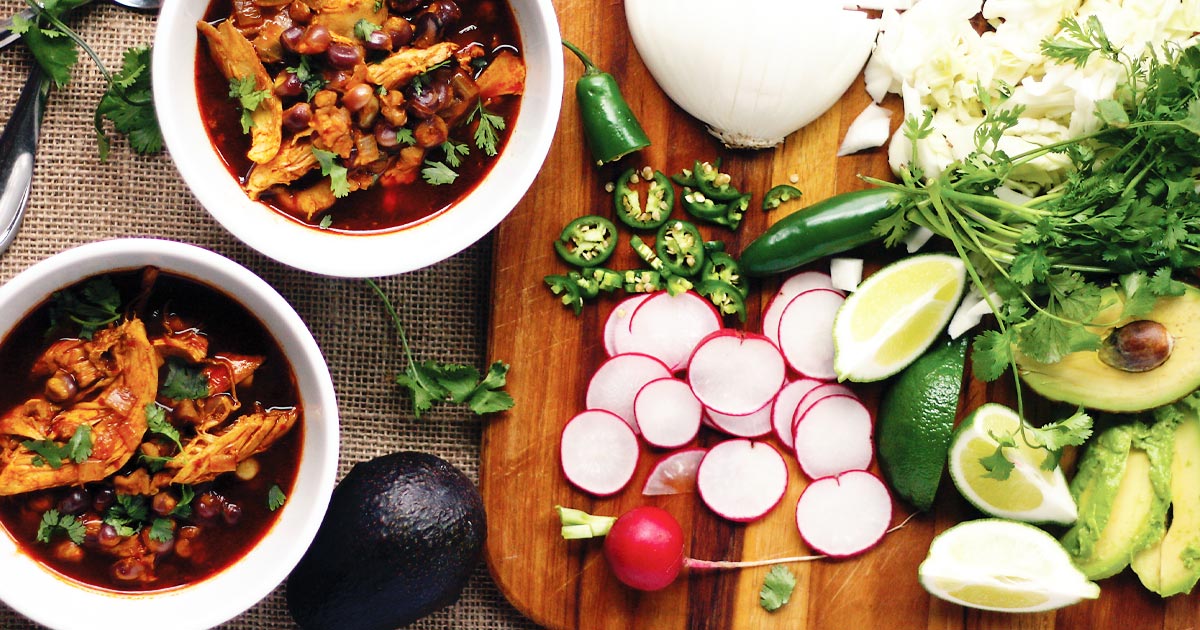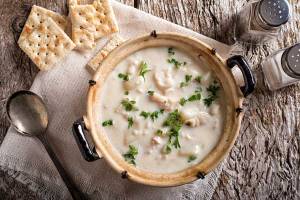This article contains affiliate links. As an Amazon Associate we earn from qualifying purchases.
I know what you’ve been thinking. What the heck is the difference between masa flour and corn meal? The question keeps you awake at night. Somehow they’re different, masa and cornmeal. Add water to masa flour, and you can make tortillas. Add water to cornmeal and you … can’t. Why? Well let me cure your insomnia, friend. It’s because of nixtamalization.
Great, you’re now thinking. What the heck is nixtamalization? Well pull up a seat, and let me tell you all about this fascinating tale. There’s a Pozole Rojo recipe for you at the end.
Nixtamal and the Fascinating Story of Nixtamalization
Nixtamalization is an ancient indigenous American process whereby maize (aka corn) is soaked and cooked in an alkaline solution and then hulled.
The alkaline solution, at least among Mesoamerican cultures, was typically slaked lime (calcium hydroxide), which you may know as cal or pickling lime. However, lye and wood ash are also sometimes used.
Now you might be thinking, “Big deal. Let’s get to the pozole rojo already.” Bear with me, because this actually is a big deal. Nixtamalization accomplishes several very important things:
It makes corn taste better. That’s a good thing, right? You bet it is.
It destroys mycotoxins, which are poisons produced by mold and other fungi commonly found on corn. Now that’s a really good thing. No one likes poison corn.
It allows masa to form into a dough. Ding ding ding! Your insomnia, remember? Ground corn meal that hasn’t undergone nixtamalization doesn’t hold together very well as a dough. This is why you can’t make tortillas. Through the process of nixtamalization, the alkaline partially breaks down the cell walls of the corn. It also turns some of the corn oil into emulsifying agents. Now you can make tortillas, and arepas, and gorditas, and tamales. These are all very good things.
It increases the nutritional value of corn. The alkali increases the amount of calcium, iron, copper, and zinc available. More importantly, corn contains niacin (vitamin B3), which is an important nutrient for human health. However, the niacin in corn isn’t bio-available for human absorption. After the process of nixtamalization, the niacin is freed and becomes bioavailable. Whoa! That’s an amazing thing!
This last point about the niacin is a huge deal. There is a rather nasty disease called pellagra, caused by a niacin deficiency, and this disease is more common in maize-eating cultures due to the low bioavailability of niacin in corn. When Europeans were introduced to corn, they adopted the grain but not the bothersome nixtamalization process. Turns out this wasn’t a very good idea. This unfortunate omission was responsible for a pellegra epidemic in the United States in the first half of the 20th century.
The first case was diagnosed in Atlanta in 1902. The patient was a poor Georgia farmer who reportedly subsisted on a diet mainly of “Indian corn” (that obviously had not undergone nixtamalization). By 1940 more than 3 million Americans had been afflicted with pellagra, and more than 100,000 died. This occurred mainly among the poor in the south, who subsisted on a corn-heavy diet.
And yet poor people in Mexico during this same time period, who also subsisted on a corn-heavy diet, didn’t experience this pellagra problem. The difference? Nixtamalization, my friend.
Nixtamal, Pozole, and Hominy
What’s in a name? I’ve been making pozole for years. It consists mainly of a broth containing chicken or pork, hominy, and dried (pozole rojo) or fresh (pozole verde) chilies. Imagine my confusion when I learned that this ancient recipe was named after the corn used to make it: pozole.
“Double-you-tee-eff?” I immediately thought, “Pozole is a kind of corn? All these years I’ve been making it with hominy!” Silly me. I was the victim of a linguistic confusion, my friend. It took me a while to figure it all out. When I did my insomnia was cured. Here is the deal.
Nixtamalization is frequently described as a Mesoamerican thing. The word nixtamalli (origin of the word nixtamal) is from the Nahualti language, which was the language of the Aztecs. It’s still spoken by over a million native people in Mexico to this day. The word pozole is also from the Nahualti language. There is archaeological evidence of nixtamalization being practiced in Guatemala and Mexico going back to at least 1200 BCE. Hello! That’s three millennia of pozole eating and tortilla eating, and tamales, and all of the other things you can make from nixtamalized corn. But that’s not the end of the story.
Now onto grits. That’s right. Grits! I promise this is going somewhere. Did you know grits are a Native American dish? I’m talking about that corn porridge that American Southerners love to eat for breakfast, in lieu of hash browns, with eggs and country ham and red-eye gravy. Those grits. Native Americans were eating those grits long before Europeans arrived in North America.
Grits are made from hominy, and “hominy” is a Powhatan (Virginia Algonquian) word. It was first recorded in English in 1629 by Captain John Smith, leader of the Virginia colony (Jamestown). And what is hominy? It’s maize that’s undergone the process of nixtamalization.
And thus nixtamalization was practiced not only in Mesoamerica, but by native peoples throughout North America well into modern day Canada. And Nixtamal is called pozole in Spanish because of the Aztecs. And nixtamal is called hominy in English because of the Powhatan. Cool, huh?
About this Pozole Rojo Recipe
Typically Pozole Rojo is made with pork, but I made mine with chicken because it’s a bit healthier that way. Whereas pozole verde (green pozole) is made with fresh green chilis and perhaps some tomatillo, pozole rojo (red pozole) is made with dried chilis. My version features ancho and fiery arbol chilies. You can use whatever dried chilies you prefer or can get your hands on. This is Mexican comfort food at it’s finest.
INGREDIENTS
Pozole
- 1 Quart of water
- 2 Dried ancho chilies
- 3 Dried pasilla chilies
- ½ Cup ground dried chile de árbol peppers
- 1 Whole chicken
- 6 Cups water
- ½ Teaspoon freshly ground black pepper
- 1 Bay leaf
- 1 Teaspoon kosher salt
- 2 Large (29 oz) cans hominy, drained and rinsed
- 2 Tablespoons extra virgin olive oil
- 1 Large white onion, diced
- 4 Cloves garlic, chopped
- Pinch of kosher salt
- ½ Teaspoon freshly ground cumin
- ½ Teaspoon ground cinnamon
- ½ Teaspoon dried Mexican oregano
Garnishes and Fixings
- Green cabbage, thinly sliced
- Radishes, thinly sliced
- White onion, finely diced
- Fresh cilantro Leaves
- Fresh avocado wedges
- Fresh lime wedges
- Crispy tostadas
- Mexican crema or sour cream
- Crumbled cotija cheese
DIRECTIONS
- Bring a quart of water to a boil in a medium pot. Break the stems off of the dried chilies and pour out the seeds. Turn off heat and add the dried chilies and cover to rehydrate for at least 15 minutes. Place the rehydrated chilies into a blender, and blend into a thick paste. Add soaking liquid as needed. Set aside.
- In a large stock pot, add the whole chicken, 6 cups of water, black pepper, bay leaf, and one teaspoon of the salt. Bring to a boil. Reduce the heat and simmer until the chicken is done (about 45 minutes). You can skip this step by buying a pre-cooked rotisserie chicken if you like. Just replace the water with store-bought chicken stock.
- Remove the chicken from the pot and allow to cool slightly. Reserve the chicken stock. Remove the skin from the chicken and pick the meat off the bones and reserve.
- In a large, heavy bottomed soup pot, sauté the onions in olive oil and remaining salt until the onions begin to soften (about 8 minutes). Add the garlic and spices, and cook a few minutes more until fragrant.
- Add the reserved chicken stock, the hominy (aka nixtamal, aka pozole), and the chili puree. Bring to a simmer.
- Remove from heat and add the reserved chicken. Serve with the garnishes of your choice on the side. MSN











